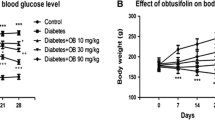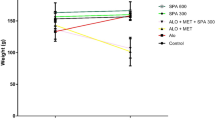Abstract
Diabetes is a chronic metabolic disorder affecting a vast number of people worldwide. Oxidative stress is the causative agent amplifying diabetic complications in various organs by generating noxious amount of free radicals. A huge interest always exists in exploring nutraceuticals from plant materials to replace synthetic drugs in order to overcome their adverse effects and also for economic reasons. The anti-diabetic efficiency of a medicinal plant, Tinospora cordifolia (TC) was studied in experimentally induced type 2 diabetes in Sprague–Dawley rats. Diabetes was induced by a combination of high fat diet (HFD) for a period of 10 weeks followed by intraperitoneal injection of streptozotocin (STZ, 35 mg/kg of body weight). Oral treatment of TC (100 and 200 mg/kg body weight) for 14 days regulated blood glucose, provoked insulin secretion and also suppressed oxidative stress marker, thiobarbituric acid reactive substances (TBARS), formation and restored cellular defence anti-oxidant markers including superoxide dismutase (SOD), glutathione peroxidase (GPx) and glutathione (GSH), in liver. Treatment with TC (100 and 200 mg/kg) also inhibited glucose 6-phosphatase and fructose 1,6-diphosphatase (p < 0.001); and restored glycogen content in liver (p < 0.005), which was also studied by histopathological staining with periodic acid–Schiff stain. In conclusion, the traditional plant Tinospora cordifolia mediates its anti-diabetic potential through mitigating oxidative stress, promoting insulin secretion and also by inhibiting gluconeogenesis and glycogenolysis, thereby regulating blood glucose.


Similar content being viewed by others
References
Singh SS, Pandey SC, Srivastava S, Gupta VS, Patro B, Ghosh AC (2003) Chemistry and medicinal properties of Tinospora cordifolia (Guduchi). Indian J Pharmacol 35:83–91
Raghunathan K, Sharma PV (1969) The aqueous extract of T. cordifolia caused reduction of blood sugar in alloxan induced hyperglycemic rats and rabbits. J Res Ind Med 3:203–211
Gupta SS, Varma SCL, Garg VP, Rai M (1967) Effect on fasting blood sugar level, glucose tolerance and adrenaline induced hyperglycemia. Indian J Exp Biol 55:733–745
Reddy SS, Ramatholisammab P, Karunaa R, Saralakumaria D (2009) Preventive effect of Tinospora cordifolia against high-fructose diet-induced insulin resistance and oxidative stress in male Wistar rats. Food Chem Toxicol 47:2224–2229
Zhang M, Lv X, Li J, Xu Z, Chen L (2008) The characterization of high-fat diet and multiple low-dose streptozotocin induced type II diabetes rat model. Exp Diabetes Res 2008:704045. doi:10.1155/2008/704045
Buettner R, Parhofer KG, Woenckhaus WCE, Kunz-Schughart LA, Scholmerich J, Bollheimer LC (2006) Defining high-fat-diet rat models: metabolic and molecular effects of different fat types. J Mol Endocrinol 36:485–501
Srinivasan K, Viswanad B, Lydia A, Kaul CL, Ramarao P (2005) Combination of high fat diet and low dose streptozotocin treated rat: a model for type 2 diabetes and pharmacological screening. Pharmacol Res 52:313–320
Kokate CK (1996) Practical pharmacognosy, 4th edn. Vallabh prakashan, Pune
Wagner H, Bladt S (1996) Plant drug analysis: a thin layer chromatography atlas, 2nd edn. Springer-Verlag, Berlin Heidelberg
Ohkawa H, Ohishi N, Yagi K (1979) Assay of lipid peroxides in animal tissues by thiobabituric acid reaction. Anal Biochem 95:351–358
Moren MS, Deplerre JN, Mannevik V (1979) Levels of glutathione-S-transferase activity in rat lung and liver. Arch Biochem Biophys 582:67–74
Kakkar P, Das B, Viswanathan PN (1984) A modified spectrophotometric assay of superoxide dismutase. Indian J Biochem Biophys 21:130–162
Rotruck JT, Pope AL, Ganther HE, Swaason AB, Hafeman DG, Hoekstra WG (1973) Selenium: biochemical role as a component of glutathione peroxidase. Science 179:588–590
Laura B (2005) Prime time for real-time PCR. Nat Methods 2:305–312
Swanson MA (1995) Phosphatases in liver I. Glucose -6-phosphatase. J Appl Biol Chem 184(2):647–706
Gancedo JM, Gancedo C (1971) Fructose-1,6-bisphosphatase, phosphofructokinase and glucose-6-phosphate dehydrogenase from fermenting and nonfermenting yeasts. Arch Mikrobiol 76:132–139
Sadasivam S, Manickam A (1996) Methods in biochemistry. In: Sadasivam S, Manickam A (eds) Carbohydrates. New Age International Pvt. Ltd, New Delhi, pp 11–12
Brownlee M (2001) Biochemistry and molecular cell biology of diabetic complications. Nature 414:813–820
Robert JK, Irina M, Joseph FT, Kan L, Jeffrey EK (2001) The potential mechanism of the diabetogenic action of streptozotocin: inhibition of pancreatic beta-cell O-GlcNAc-selective N-acetyl-beta-d-glucosaminidase. J Biochem 356:31–41
Zhao S, Chu Y, Zhang C (2008) Diet induced central obesity and insulin resistance in rabbits. J Anim Physiol Anim Nutr 92:105–111
Bayens JW (1991) Role of oxidative stress in the development of complications in diabetes. Diabetes 40:405–412
Kakkar R, Kalra J, Mantha SV, Prasad K (1995) Lipid peroxidation and activity of antioxidant enzymes in diabetic rats. Mol Cell Biochem 151:113–119
Andrew A, Richard EG, Thai Kerri, Renae MG, Robyn GL, Alison JC, Kim AC, Yuan Z, Andrew MH, Per KC, Carol AP, Weier Q, Sih MT, Hans-Henrik P, Darren J (2009) Expression, localization, and function of the thioredoxin system in diabetic nephropathy. J Am Soc Nephrol 20:730–741
Consoli A, Nurjhan N, Capani F, Gerich J (1989) Predominant role of gluconeogenesis in increased hepatic glucose production in NIDDM. Diabetes 38:550–557
Nagaraja PK, Kammar KF, Devi Sheela (2007) Modulation of morphology and some gluconeogenic enzymes activity by Tinospora cordifolia (Willd.) in diabetic rat kidney. Biomed Res 18:179–183
Acknowledgements
The authors thank the Department of Science and Technology (Govt. of India) for providing fellowship, staff of the Centre for Toxicology and Developmental Research (CEFT) for help in conducting animal studies and the Central Research Facility (CRF) of Sri Ramachandra University for running the RT-PCR.
Author information
Authors and Affiliations
Corresponding author
Rights and permissions
About this article
Cite this article
Sangeetha, M.K., Balaji Raghavendran, H.R., Gayathri, V. et al. Tinospora cordifolia attenuates oxidative stress and distorted carbohydrate metabolism in experimentally induced type 2 diabetes in rats. J Nat Med 65, 544–550 (2011). https://doi.org/10.1007/s11418-011-0538-6
Received:
Accepted:
Published:
Issue Date:
DOI: https://doi.org/10.1007/s11418-011-0538-6




